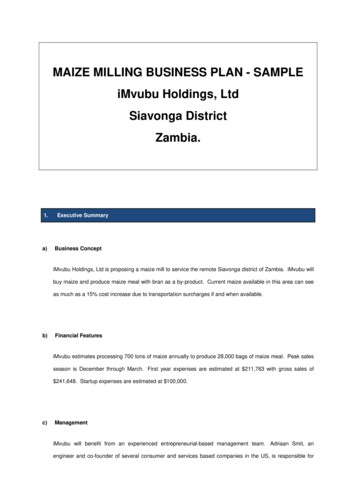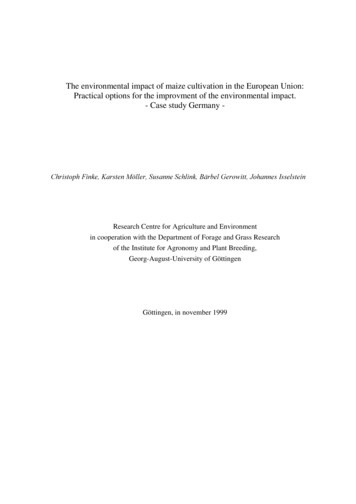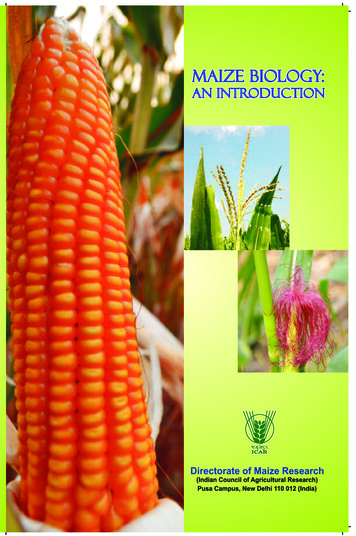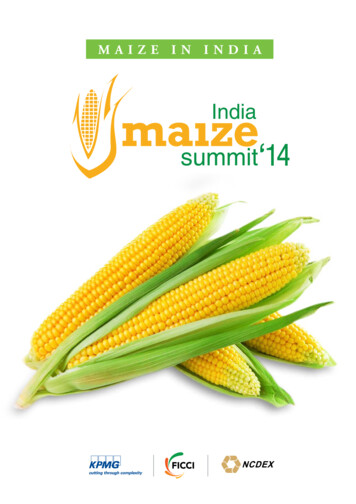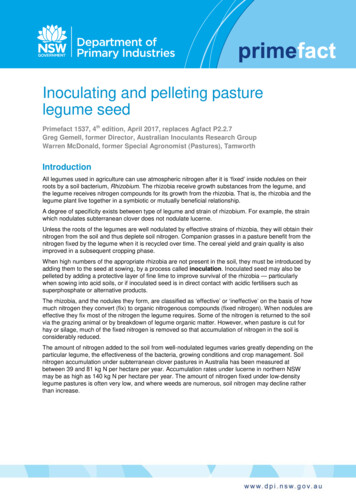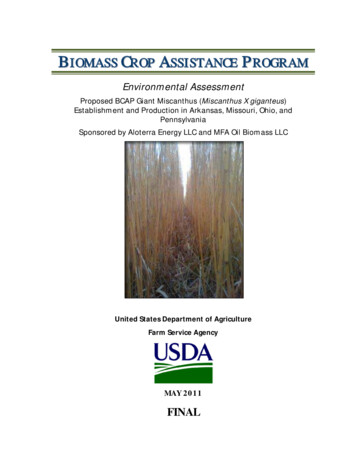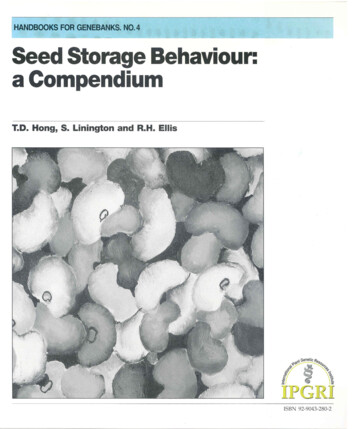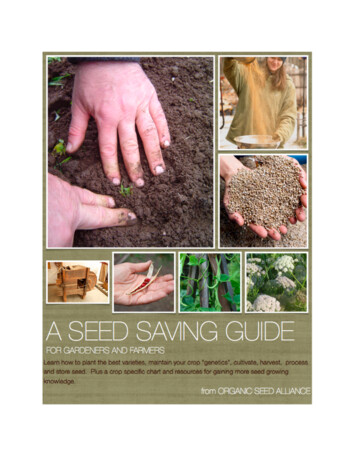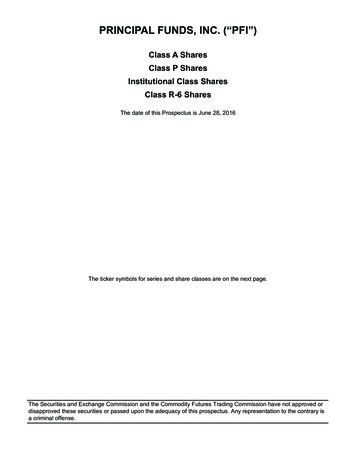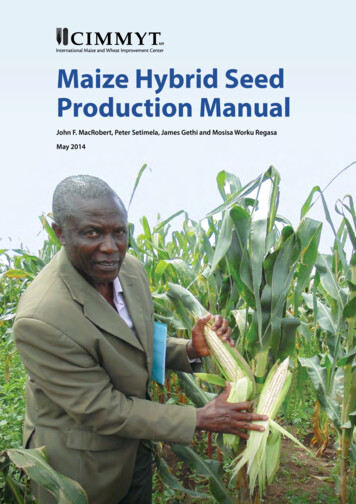
Transcription
Maize Hybrid SeedProduction ManualJohn F. MacRobert, Peter Setimela, James Gethi and Mosisa Worku RegasaMay 2014
Maize Hybrid SeedProduction ManualJohn F. MacRobert, Peter Setimela, James Gethiand Mosisa Worku RegasaMay 2014
The International Maize and Wheat Improvement Center, known by its Spanishacronym, CIMMYT (www.cimmyt.org), is a not-for-profit research and trainingorganization with partners in over 100 countries. The center works to sustainablyincrease the productivity of maize and wheat systems and thus ensure global foodsecurity and reduce poverty. The center’s outputs and services include improvedmaize and wheat varieties and cropping systems, the conservation of maize and wheatgenetic resources, and capacity building. CIMMYT belongs to and is funded by theConsultative Group on International Agricultural Research (CGIAR) (www.cgiar.org)and also receives support from national governments, foundations, development banksand other public and private agencies. CIMMYT is particularly grateful for the generous,unrestricted funding that has kept the center strong and effective over many years. International Maize and Wheat Improvement Center (CIMMYT), 2014. All rightsreserved. The designations employed in the presentation of materials in this publicationdo not imply the expression of any opinion whatsoever on the part of CIMMYT or itscontributory organizations concerning the legal status of any country, territory, city orarea, or of its authorities, or concerning the delimitation of its frontiers or boundaries.CIMMYT encourages fair use of this material. Proper citation is requested.Correct citation: MacRobert, J.F., P.S. Setimela, J. Gethi, and M. Worku. 2014. MaizeHybrid Seed Production Manual. Mexico, D.F.: CIMMYT.ISBN: 978-607-8263-26-4AGROVOC descriptors: Maize; Hybrids; Varieties; Seed production; Seed industry;Plant breeding; Plant geneticsAdditional Keywords: CIMMYTAGRIS category codes: F03 Seed ProductionF30 Plant Genetics and BreedingDewey decimal classification: 631.523Cover photo: Mosisa Regasa/CIMMYTPrinted in Mexico.ii
ContentsIntroduction . 1What is a maize hybrid? . 1Hybrid composition . 2Seed classes . 3Planning seed production requirements . 4Pre-basic, basic and certified seed production .5Field management of hybrid seed production . 6Flow diagram for seed production . 7Conclusion . 23Annex 1. Example of a seed crop budget . 24Annex 2. Example of a record sheet for maize hybrid seed production . 25Annex 3. Conversion factors . 26iii
TablesTable 1. Common types of maize hybrids and their general characteristics . 2Table 2. The seed classes that normally apply to maize hybrid seed production, especially incountries following the OECD certification standards . 4Table 3. The number of isolation seed production fields for the production of different hybrid types . 4Table 4. The minimum Southern Africa Development Community seed certification standards . 6Table 5. An example of a planting instruction for the production of a single-cross hybrid on 15 ha,assuming there will be 10% in-field loss of emerging plants, post germination . 10Table 6. Distinguishing characteristics of maize plants during the vegetative and flowering stages . 11Table 7. Equilibrium moisture contents of grain and cobs on intact cobs . 18Table 8. Maximum recommended air temperature for drying maize seed, as a function ofseed moisture content . 19Table 9. Seed classes based on width and thickness . 20Table 10. Average thousand kernel weight and number of kernels per kilogram ofvarious classes of seed . 20iv
FiguresFigure 1. Hybrid maize seed is produced by using designated female and male parents,removing the tassels from the female plants before silk emergence and allowingmale plants to provide the pollen for fertilizing the silks . 1Figure 2. Diagrammatic representation of male and female rows in a maize hybrid seedproduction field . 2Figure 3. Schematic representation of the scale-up of maize hybrid seed from breeder’s seedthrough basic seed and certified seed production for commercial productionin farmers’ fields . 4Figure 4. A simple means to calculate the required seed population to be sown for maize, basedon the desired plant population, germination percentage and expected field losses . 5Figure 5. Flow diagram of hybrid maize seed production for a seed grower . 8Figure 6. An example of the progress in silk emergence of the single-cross female and in pollenshedding of the inbred male, in a three-way hybrid maize seed production field . 13Figure 7. Schematic presentation of the change in seed viability (germination percent and vigor)with time after fertilization of the embryo . 15Figure 8. The decrease in the moisture content of seed remaining on the plants with time afterphysiological maturity, where the cob sheath leaves were either opened or untreated . 16Figure 9. Diagrammatic representation of the potential storage life of seed as a function of airtemperature and seed moisture content . 17Figure 10. Schematic diagram of a batch drier with a sloping plenum to facilitate emptying . 19Figure 11. Seed classes . 20Figure 12. Effect of thousand seed weight on the seed rate and seed requirement per hectare . 20v
vi
With maize, there are a number of possible kindsof hybrids, such as single-cross, three-way, doublecross and top-cross hybrids. These hybrids differin their parental composition but, in all cases, thehybrid seed sold to farmers is a cross betweentwo parents – a female and a male. Since maizehas separate male and female plant parts, it isrelatively easy to make a cross between two plants.In a hybrid seed production field, male and femaleparents are planted in sequential row patterns,usually with three-to-six times the number offemale plants or rows to a single male plant orrow. The male flower (tassel) of the female plant isremoved (detasseled) before pollen shed, so thatthe only source of pollen for the female flower (thecob or ear) on the female plants is the tassels on themale plants (Figure 1). Detasseling of the femaleis necessary to prevent any pollen from the femalepollinating the female silks. If this occurs, knownas “female-selfing,” the result is a significantloss of seed quality that will clearly be seen in acrop grown from the seed. Female-selfing is to beavoided at all costs.IntroductionMaize hybrid seed provides farmers with varietiescontaining improved genetics, such as high yieldpotential and unique trait combinations to counterdiseases and adverse growing conditions. However,the quality of hybrid seed depends greatly onfield production methods, both in adherence toquality assurance standards and implementationof appropriate agronomic management. Whileopen pollinated maize seed production is relativelystraightforward, hybrid seed production requiresadditional field practices that are critical to success.Hybrid maize seed production involves deliberatelycrossing a female parent population with a maleparent in isolated fields. Thus, from the verystart of hybrid seed production, the identityand arrangement of the two parent populationsdetermine the outcome. Each hybrid variety iscomposed of a specific combination of a female(seed bearing) and male (pollen providing) parents.The field management of the two parents is alsoimportant and requires attention to timing ofplanting, elimination of off-types, removal of tasselsfrom the females before pollen shedding, separateharvesting of the female seed and careful shellingand processing of the seed to maintain seed quality.The sequentially dependent nature of the processmeans that any errors in earlier stages have asignificant impact on following stages and majorerrors or problems can result in complete failure orrejection of the crop. This manual provides a guideto maize hybrid seed production, with particularreference to field procedures, so that seed growersand seed companies can cost-effectively obtainproductive and quality seed suitable for farmers.The ratio of the number of female rows to malerows in the field is usually on the order of 3:1 forsingle-crosses and three-ways but may extend to 8:1for double-cross hybrids (Figure 2). The actual ratiothat is planted depends on a number of factors, butprincipally on the pollen production of the male,nlePolWhat is a maize hybrid?Simply put, a maize hybrid results from thefertilization of one maize plant by anothergenetically un-related plant. The plant that bearsthe seed is called the female or seed parent, whilethe plant that provides the pollen to fertilize thefemale is called the male or pollen parent. In otherwords, the female plant is crossed with the maleplant to produce hybrid seed. This seed bears aunique genetic make-up from the female and maleparents and will produce a plant with particularcharacteristics. Plant breeders produce the femaleand male parents of each hybrid to generateprogeny with particular characteristics, such asplant maturity, disease resistance, grain color,food processing quality and so on. It is this uniquehybrid seed that farmers will sow in their fields.When a farmer purchases a particular hybrid, heor she expects the seed to perform in the field asdesignated by the variety description. l clay content, soil pH and soil test results.Lime should be applied three to six months beforesowing, to have time to take effect (lime applied atsowing will not be effective for the emerging crop).Field management of hybrid seed productionSince seed has higher value than grain, the standardof management to be applied ought also be higher.However, in principle, agronomic practices for seedcrops are similar to those for normal crops, in thatdue attention must be given to field practices thatimprove yield (e.g., optimizing timing of planting,appropriate and calibrated fertilizer application,conservation agriculture and water management)and to minimizing factors that reduce yield (e.g.,water stress, weeds, pests and diseases). In addition,safe procedures must be followed when usingmachinery or applying fertilizers and chemicals.In types of hybrid seed production where one orboth parents are inbred lines, extra care needs to betaken with those lines, which tend to be weak andmore susceptible to environmental stresses (e.g.,Table 4. The minimum Southern Africa Development Community (SADC) seed certification standards. BS basic seed;CS certified seed; OPV open pollinated variety. Standards might be different in individual SADC countries and elsewhere.Field standardsCommonnameMinimumisolationdistance (m)Maximum % ofoff-types (basedon 1,000 plants)Laboratory standardsMinimumnumber ofinspectionsMinimumgermination(%)Minimum %pure seed(by weight)Maximummoisture(%)BS(B)CS(C)BS(B)CS(C)BS
and a significantly higher yield than either of the two parents. This is known as "hybrid vigor," and it is this vigor that is exploited in hybrids and makes hybrid varieties useful to farmers. The most common types of hybrids in maize are single-cross, three-way and double-cross hybrids (Table 1). A single-cross hybrid is made by crossing
